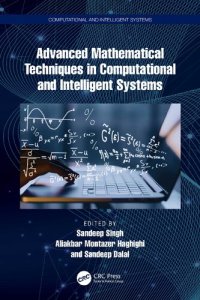
Ebook: Advanced Mathematical Techniques in Computational and Intelligent Systems
- Genre: Computers // Software: Systems: scientific computing
- Series: Computational and Intelligent Systems Series
- Year: 2023
- Publisher: CRC Press
- Language: English
- pdf
This book comprehensively discusses the modeling of real-world industrial problems and innovative optimization techniques such as heuristics, finite methods, operation research techniques, intelligent algorithms, and agent- based methods.
The field of computational and intelligent systems has seen remarkable advancements in recent years. Mathematical techniques are at the heart of these developments, providing a powerful toolset for solving complex problems in a wide range of applications.
This edited book, Advanced Mathematical Techniques Applicable in Computational and Intelligent Systems, brings together a diverse collection of chapters written by experts in their respective fields. This book covers a broad spectrum of mathematical techniques and their applications in computational and intelligent systems. It includes topics ranging from optimization techniques to mathematical modeling of biological systems, and from graph theory to public key cryptography.
Solving optimization problems to boost production is where Machine Learning comes to the rescue. Operators perform the optimization on the basis of their personal experience, which adds up over time as they get to know about handling the process. This capability of learning from one’s own experience is the best part of Machine Learning. Machine Learning algorithms analyse a huge amount of previous data from the sensors and they can learn to know the complicated relation between different parameters and how they affect production.
Application of graph theory in search of websites and web pages: Website designing can be drawn as a graph, with web pages represented by vertices and hyperlinks between them using edges within the graph. This idea is called web graph. It makes discovering exciting data. Various software areas of the graph are in the net network. Here vertices represent training items, and each vertex represents one type of object, and each vertex represents one type of object that is associated with each vertex rep- resenting different types of objects. In graph theory, this type of graph is known as a complete bipartite graph. The use of graph illustration in website development also has several advantages: (i) search and community discovery; (ii) graph representation (directed graph) in website application evaluation and link size and (iii) detect all associated factors and provide easy identification.
Discusses advanced techniques such as key cell, Mobius inversion, and zero suffix techniques to find initial feasible solutions to optimization problems.
Provides a useful guide toward the development of a sustainable model for disaster management.
Presents optimized hybrid block method techniques to solve mathematical problems existing in the industries.
Covers mathematical techniques such as Laplace transformation, stochastic process, and differential techniques related to reliability theory.
Highlights application on smart agriculture, smart healthcare, techniques for disaster management, and smart manufacturing.
Advanced Mathematical Techniques in Computational and Intelligent Systems is primarily written for graduate and senior undergraduate students, as well as academic researchers in electrical engineering, electronics and communications engineering, computer engineering, and mathematics.
The field of computational and intelligent systems has seen remarkable advancements in recent years. Mathematical techniques are at the heart of these developments, providing a powerful toolset for solving complex problems in a wide range of applications.
This edited book, Advanced Mathematical Techniques Applicable in Computational and Intelligent Systems, brings together a diverse collection of chapters written by experts in their respective fields. This book covers a broad spectrum of mathematical techniques and their applications in computational and intelligent systems. It includes topics ranging from optimization techniques to mathematical modeling of biological systems, and from graph theory to public key cryptography.
Solving optimization problems to boost production is where Machine Learning comes to the rescue. Operators perform the optimization on the basis of their personal experience, which adds up over time as they get to know about handling the process. This capability of learning from one’s own experience is the best part of Machine Learning. Machine Learning algorithms analyse a huge amount of previous data from the sensors and they can learn to know the complicated relation between different parameters and how they affect production.
Application of graph theory in search of websites and web pages: Website designing can be drawn as a graph, with web pages represented by vertices and hyperlinks between them using edges within the graph. This idea is called web graph. It makes discovering exciting data. Various software areas of the graph are in the net network. Here vertices represent training items, and each vertex represents one type of object, and each vertex represents one type of object that is associated with each vertex rep- resenting different types of objects. In graph theory, this type of graph is known as a complete bipartite graph. The use of graph illustration in website development also has several advantages: (i) search and community discovery; (ii) graph representation (directed graph) in website application evaluation and link size and (iii) detect all associated factors and provide easy identification.
Discusses advanced techniques such as key cell, Mobius inversion, and zero suffix techniques to find initial feasible solutions to optimization problems.
Provides a useful guide toward the development of a sustainable model for disaster management.
Presents optimized hybrid block method techniques to solve mathematical problems existing in the industries.
Covers mathematical techniques such as Laplace transformation, stochastic process, and differential techniques related to reliability theory.
Highlights application on smart agriculture, smart healthcare, techniques for disaster management, and smart manufacturing.
Advanced Mathematical Techniques in Computational and Intelligent Systems is primarily written for graduate and senior undergraduate students, as well as academic researchers in electrical engineering, electronics and communications engineering, computer engineering, and mathematics.
Download the book Advanced Mathematical Techniques in Computational and Intelligent Systems for free or read online
Continue reading on any device:

Last viewed books
Related books
{related-news}
Comments (0)